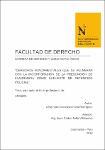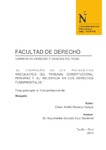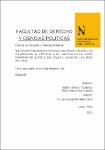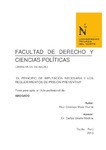Mostrar el registro sencillo del ítem
Derechos fundamentales que se vulneran con la incorporación de la presunción de flagrancia como supuesto de detención policial
| dc.contributor.advisor | Tello Villanueva, Juan Carlos | |
| dc.contributor.author | Goicochea Rodríguez, Leydi Vanessa | |
| dc.date.accessioned | 2018-08-15T17:56:57Z | |
| dc.date.available | 2018-08-15T17:56:57Z | |
| dc.date.issued | 2018-07-20 | |
| dc.identifier.citation | Goicochea, L. V. (2018). Derechos fundamentales que se vulneran con la incorporación de la presunción de flagrancia como supuesto de detención policial (Tesis de licenciatura). Repositorio de la Universidad Privada del Norte. Recuperado de http://hdl.handle.net/11537/13690 | es_PE |
| dc.identifier.other | TES 340 GOIC 2018 | es_PE |
| dc.identifier.uri | https://hdl.handle.net/11537/13690 | |
| dc.description.abstract | RESUMEN La institución de la flagrancia delictiva, constituye una de las formas en las que se puede privar legalmente a una persona de su derecho a la libertad. Es así, que su gran importancia radica en que ésta se encuentra ligada estrechamente a derechos fundamentales, los cuales deben ser plenamente protegidos por un Estado Constitucional de Derecho. Debido a la concomitancia con derechos fundamentales es que la figura es objeto de discusión por parte de los doctrinarios y a lo largo de su vigencia ha sufrido distintas modificaciones normativas, en las cuales principalmente se discutía si realizar o no una interpretación extensiva de la figura y con ello ampliar los supuestos de detención policial. Es así, que en la legislación actual a la figura de la flagrancia se han incorporado nuevos elementos que facultan la detención del agente policial por ejemplo en casos de identificación por medio audiovisual, sindicación por testigo, hallazgo de huellas o instrumentos del delito e incluso la facultad de detener hasta por un lapso de 24 horas después de cometido el hecho punible. Donde algunos elementos no respetan lo resuelto por el Tribunal Constitucional, que en reiterada jurisprudencia ha determinado que para la correcta configuración de la flagrancia delictiva deben concurrir ineludiblemente los elementos de inmediatez temporal e inmediatez personal, los cuales brindan constancia sensorial del hecho y con ello prueba irrefutable de la autoría del agente infractor. Es por ello que, el objetivo de la presente investigación es determinar cuáles son los derechos fundamentales que se vulneran a raíz de la interpretación extensiva de la flagrancia en la ley vigente. En ese orden de ideas, la presente tesis tiene como puntos de referencia identificar cuáles son los componentes que no guardan relación con los elementos sustanciales de la figura, identificándolos en parte del inciso tercero y totalidad del inciso cuarto del artículo 259° del Código Procesal Penal, pues son considerados como una flagrancia ficta o presunción de flagrancia, en razón de que no guardan relación con la naturaleza jurídica y únicamente generan su desnaturalización, lo que conlleva a una detención arbitraria que vulnera derechos fundamentales. Por lo que, consideramos se debe asumir una interpretación restrictiva, en la que se respete los elementos fundamentales que configuran la esencia de la figura. Sin embargo, como excepción a la desnaturalización hemos considerado la pertinencia de la inclusión de identificación por medio audiovisual, en razón de que aun cuando el infractor ha logrado desvincularse de la escena delictiva, existe el registro fílmico que brinda constancia sensorial del hecho de manera indirecta pero fiable, constituyéndose así en una suerte de flexibilización de la figura que va acorde al dinamismo del derecho y acoplamiento a las nuevas herramientas tecnológicas; pero sin dejar la posibilidad abierta a situaciones atentatorias de vulneración de derechos. Con lo que se pretende determinar cuál es la interpretación adecuada de la flagrancia y en consecuencia evitar la contradicción con el Tribunal Constitucional, que únicamente genera desorden en nuestro ordenamiento jurídico y consecuentemente impedir se continúe incurriendo en detenciones arbitrarias. | es_PE |
| dc.description.abstract | ABSTRACT The institution of the Flagrancia Delictiva is one of the ways in which a person can be legally deprived of his right to freedom. Thus, its great importance is that it is closely linked to fundamental rights, which must be fully protected by a Constitutional State of Law. Due to the concomitance with fundamental rights is that the figure is the subject of discussion by the doctrinaires and throughout its validity has undergone various regulatory changes, which mainly discussed whether or not to perform an extensive interpretation of the figure and with This will increase the cases of police detention. Thus, in the current legislation to the figure of the flagrance have been incorporated new elements that empower the arrest of the police agent for example in cases of identification by audiovisual means, syndication by witness, finding traces or instruments of crime and even the ability to stop for a period of 24 hours after committing the punishable act. Where some elements do not respect what was resolved by the Constitutional Court, which in settled case law has determined that for the correct configuration of the Criminal Flagrance the elements of temporary immediacy and personal immediacy must inevitably concur, which provide sensory constancy of the fact and thereby prove irrefutable of the authorship of the offending agent. That is why, the objective of the present investigation is to determine which are the fundamental rights that are violated as a result of the extensive interpretation of the Flagrancy in the current law. In this order of ideas, this thesis has as reference points to identify which are the components that are not related to the substantial elements of the figure, identifying them in part of the third and entire paragraph of the fourth paragraph of article 259 of the Code of Criminal Procedure , because they are considered a flagrant fiction or presumption of flagrancy, because they are not related to the legal nature and only generate their denaturalization, which leads to an arbitrary detention that violates fundamental rights. Therefore, we consider that a restrictive interpretation must be assumed, in which the fundamental elements that make up the essence of the figure are respected. However, as an exception to the denaturalization we have considered the relevance of the inclusion of identification by audiovisual means, because even though the offender has managed to dissociate himself from the criminal scene, there is a filmic record that provides indirect evidence of the fact but reliable, thus constituting a kind of flexibility of the figure that is consistent with the dynamism of the right and coupling to new technological tools; but without leaving the possibility open to situations of violation of rights. With what is intended to determine what is the proper interpretation of the flagrance and consequently avoid contradiction with the Constitutional Court, which only generates disorder in our legal system and consequently prevent arbitrary arrests continue to be made. | es_PE |
| dc.description.uri | Tesis | es_PE |
| dc.format | application/pdf | es_PE |
| dc.language.iso | spa | es_PE |
| dc.publisher | Universidad Privada del Norte | es_PE |
| dc.rights | info:eu-repo/semantics/closedAccess | es_PE |
| dc.source | Universidad Privada del Norte | es_PE |
| dc.source | Repositorio Institucional - UPN | es_PE |
| dc.subject | Derecho penal | es_PE |
| dc.subject | Detención | es_PE |
| dc.subject | Derecho procesal | es_PE |
| dc.title | Derechos fundamentales que se vulneran con la incorporación de la presunción de flagrancia como supuesto de detención policial | es_PE |
| dc.type | info:eu-repo/semantics/bachelorThesis | es_PE |
| thesis.degree.grantor | Universidad Privada del Norte. Facultad de Derecho y Ciencias Políticas | es_PE |
| thesis.degree.level | Título Profesional | es_PE |
| thesis.degree.discipline | Derecho y Ciencias Políticas | es_PE |
| thesis.degree.name | Abogado | es_PE |
| dc.publisher.country | PE | es_PE |
| dc.subject.ocde | https://purl.org/pe-repo/ocde/ford#5.05.01 | es_PE |
| thesis.degree.program | Pregrado | es_PE |
| dc.description.sede | Cajamarca | es_PE |
| renati.discipline | 421056 | es_PE |
| renati.level | https://purl.org/pe-repo/renati/level#tituloProfesional | es_PE |
| renati.type | https://purl.org/pe-repo/renati/type#tesis | es_PE |
Ficheros en el ítem
Este ítem aparece en la(s) siguiente(s) colección(ones)
-
Tesis [828]





